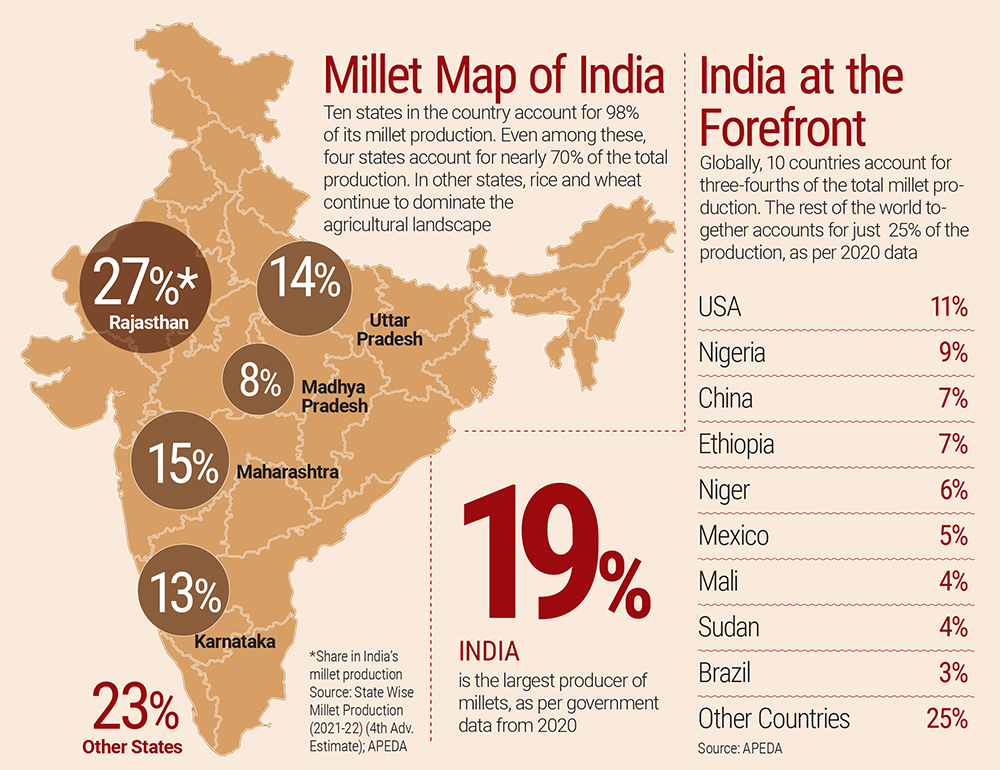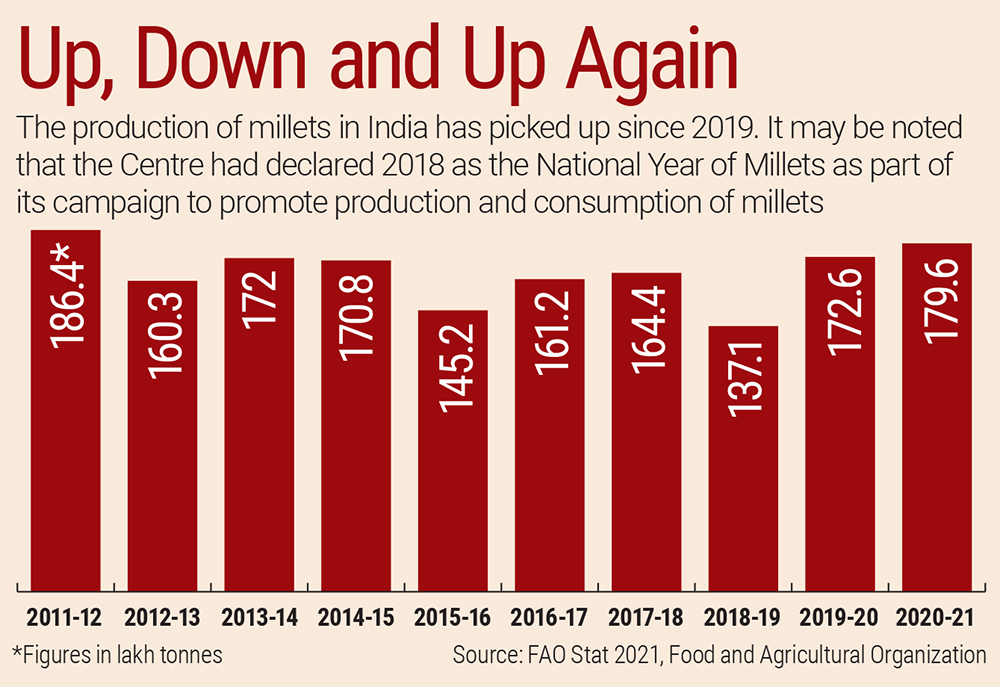I may be small
but I am strong
I grow where
others cannot …
I nurture soils
and ecosystems …
So, bring me back
to your table
I am millets.
—From a video released by the Food and Agriculture Organization (FAO) to mark the International Year of Millets 2023
Millets—once the quintessential diet of India before fading into near oblivion—are returning to the country’s food landscape, as it looks to the tiny coarse cereals to build its food and nutritional security and help meet its environment protection goals. With their domestic as well as export potential, they have also become the latest player in India’s growth story.
Nudged by India, the United Nations declared 2023 as the International Year of Millets. In the budget 2023, Union finance minister Nirmala Sitharaman announced plans to make India a hub for millets—or shree anna, as Prime Minister Narendra Modi calls them. India is also utilising its G20 presidency this year to promote awareness about millets. In February, it presented the plan for Millet International Initiative for Research and Awareness (MIIRA) at the first Agriculture Deputies Meeting under the Agriculture Working Group of G20 in Indore.
Hailed as “smart foods”, millets are nutritionally rich with several health benefits, are climate-resilient and ecologically sustainable. Their nutritional value is higher than that of the more popularly consumed wheat and rice. The Market Intelligence Report for Millets by Agricultural and Processed Food Products Export Development Authority (APEDA) states that the rise in diseases like diabetes, obesity and cardiovascular ailments will prompt millet consumption as they are rich in proteins and minerals like calcium and iron that help deal with these diseases.
“Nutrition status is a strong predictor of improved outcomes in TB patients. Functional millets foods endowed with phytonutrients and polyphenols can reduce oxidative stress and modulate immune response,” says Raj Bhandari, a paediatrician and member of the National Millets Taskforce of NITI Aayog.
The demand for nutritious options has brought fast-moving consumer goods brands like Britannia, Unilever and Tata to the domestic millet market. Prashant Parameswaran, managing director and chief executive officer of Tata Soulfull, which sells millet-based products, says, “There has recently been a paradigm shift in customer tastes that has penetrated the food and snacking businesses. They are making more informed health decisions and moving towards a more sustainable lifestyle. Therefore, millet-based healthy snacking options have greatly become a popular choice among consumers.”
Millets in Future
Rice cultivation is not sustainable due to its higher water footprint, while millet can be “grown on land that is not (or no longer) suitable for growing rice,” points out the World Economic Forum (WEF). The Food and Agriculture Organization (FAO) of the United Nations, in an article titled Six reasons to bring millets to the market, states that at present millets hold less than 3% of the global grains trade.
However, dietary patterns have shifted as a result of changing lifestyles and cultural norms, creating an enormous opportunity for healthy snack manufacturers, says Parameswaran. “Ancient grain millets are being reintroduced into our diets in order to blend the utility of today with the goodness of the past. Since flavour is an essential component of convenience snacking, several businesses are experimenting with new flavours to obtain a competitive advantage in the market. Marketers are coming up with new flavours and ingredients to cater to consumers’ shifting palates,” Parmeswaran adds.

According to FAO, India produced 172.6 lakh tonnes of millets in 2019–20, which was 80% of Asia’s and 20% of the global production. The production rose to 179.6 lakh tonnes in 2020–21.
As the biggest producer and among the top exporters of millets, India is well-poised to be the food and nutrition basket of the world, says Bhandari. The government is rallying agencies like the NITI Aayog, APEDA, agricultural and commerce ministries and state governments to take measures to promote production, supply, exports and consumption of the “superfood”.
A report, Indian Superfood Millets: A USD 2 Billion Export Opportunity by APEDA and Yes Bank, states, “With a projected surplus of 0.56 Mn MT millets in 2030, India has the potential to export millet and millet based value-added products worth USD 2 Billion.” Millets can accelerate India’s agricultural exports and also play an important part in providing nutritional security to the world, it adds.
Not Without Challenges
According to a 2019 article, The impact of the Green Revolution on indigenous crops of India published in the Journal of Ethnic Foods, post-Green Revolution in the 1960s, the production of wheat and rice doubled due to initiatives of the government, but that of other food crops, such as indigenous rice varieties and millets, declined.
This argument is upheld by other researchers as well. An article, Water footprint of our diet and ways to reduce it, published by NGO Citizen Consumer and Civic Action Group, cites studies that show that the Green Revolution and the public distribution system are “together responsible for replacing nutrient rich millets with wheat and rice, which led to a high prevalence of iron deficiency among the Indian population”. “The dominance of rice and wheat translated into changes in consumption patterns. Consumption of coarse cereals … declined,” states a paper published by the International Nutrition Foundation in the context of dietary changes in India after the Green Revolution.
According to a report published in March this year, titled Millet cultivation in India: History and trends by India Development Review (IDR), the area under millet cultivation in India is decreasing since 1971–72. Per capita availability “is at its lowest since the all-time high seen in 2019”, it adds.

Low productivity of millets is also an issue. The WEF notes that farmers in Punjab started growing millets instead of rice as it does not require much water. However, its production per unit of land is six times lower than that of rice. Hence, millet cannot be a universal solution, but should be a part of a package of crops that can be grown more sustainably and are adaptable to climate variations, it suggests.
According to Atal New India Challenge of the NITI Aayog, “Lack of public awareness about nutritional benefit of millets has led to limited adoption of millet-based products. Limited distribution and lack of market knowledge has led to sub-optimal reach, lower price realization and wastage.”
One of the challenges that directly affects the commercial viability of millets is the lack of processing efficiency which is required to convert them from an inedible to an edible form and enhance their quality. Centralised processing faces a problem due to different sizes and varieties of millets. There is also a lack of machinery for dehusking and polishing small millets. Short shelf life because of moisture further adds to the woes of millets.
The report in the Journal of Ethnic Foods lists more challenges in reviving indigenous species: farmers’ willingness, identification of farmers with traditional knowledge of crop cultivation, encouraging those with large landholdings to cultivate indigenous crops, awareness among the consumers and stakeholders about the ecological and health benefits of indigenous varieties, government support for the propagation of these crops and development of suitable mechanisation.
Mahesh Londhe, founder of Pune-based start-up Agrozee Organics, says, “With 2023 named as the International Year of Millets, the demand for millets is rising, but the farmer is unaware of what it is all about and is not gaining any benefits.” He elaborates with an example. “If brown top millet costs Rs 250 for a kilogramme, the farmer gets just Rs 60 to Rs 65 out of it. Today, the demand for brown top, which is found in limited areas in India, is rising. So, farmers, traders and farmer producer organisations have suddenly increased its price. By the time it reaches the customer, the price increases even more,” he says.
But, the other side of the spectrum is equally real, where farmers are faced with losses. Londhe suggests introduction of minimum support price (MSP) for all millets. “MSP is needed to deal with price fluctuation. For now, MSP for millets is available only for ragi, jowar and bajra. Farmers want that all millets should be procured at MSP. There should be focus on how the farmer can benefit,” he avers.
Talking about the lack of price incentive, Krishna Veni, programme coordinator at the Millet Network of India, says, “We support the Millet Sisters, a network of small-scale women farmers, with a processing machine to ease the drudgery of processing of millets. Even then, they do not get a good market price and these peasant farmers do not have any storage facilities to wait for market prices to rise.”
Wekoweu Tsuhah, state coordinator of NEN Nagaland, a women’s organisation, adds, “Decreased and fragmented cultivation have made farmers more vulnerable as they face more pest attacks. Alienation of the younger generation from farming has led to a labour deficit in the communities and hence the work burden has fallen on women and elders. Lack of technological support in dehulling and dehusking has demotivated farmers as manual processing is tedious.”
Reclaiming Their Space
The climate crisis is worsening, opening windows of opportunity for revisiting sustainable and resilient food systems. Market Intelligence Report for millets by APEDA states that millets have low carbon and water footprint, can tolerate high temperatures and are able to survive on poor quality soil with minimum inputs. With Big Food companies showing interest in millets and state government working in mission mode, the time is ripe for millets to reclaim their lost position.
However, for that, the “smart foods” will need some smart work by the government and other agencies involved in the entire supply chain. In Londhe’s words, it is only in the in-between spaces where millets are being celebrated. To reach a level where they can make a difference to the food and climate ecosystems, millets will need more than celebrations and exotic nomenclature.











